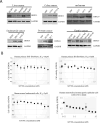An RNA Helicase DHX33 Inhibitor Shows Broad Anticancer Activity via Inducing Ferroptosis in Cancer Cells
- PMID: 38973855
- PMCID: PMC11223218
- DOI: 10.1021/acsomega.4c02265
An RNA Helicase DHX33 Inhibitor Shows Broad Anticancer Activity via Inducing Ferroptosis in Cancer Cells
Abstract
RNA helicase DHX33 has been identified as a critical factor promoting cancer development. In the present study, a previously developed small molecule inhibitor for DHX33, KY386, was found to robustly kill cancer cells via a new path, the ferroptosis pathway. Mechanistically, DHX33 promotes the expression of critical players in lipid metabolism including FADS1, FADS2, and SCD1 genes, thereby sensitizing cancer cells to ferroptosis mediated cell death. Our study reveals a novel mechanism of DHX33 in promoting tumorigenesis and highlights that pharmacological targeting DHX33 can be a feasible option in human cancers. Normally differentiated cells are insensitive to DHX33 inhibition, and DHX33 inhibitors have little cellular toxicity in vitro and in vivo. Our studies demonstrated that DHX33 inhibitors can be promising anticancer agents with great potential for cancer treatment.
© 2024 The Authors. Published by American Chemical Society.
Conflict of interest statement
The authors declare no competing financial interest.
Figures







Similar articles
-
Development of small molecule inhibitors targeting RNA helicase DHX33 as anti-cancer agents.Bioorg Med Chem Lett. 2023 Nov 15;96:129505. doi: 10.1016/j.bmcl.2023.129505. Epub 2023 Oct 12. Bioorg Med Chem Lett. 2023. PMID: 37838340
-
Targeting RNA helicase DHX33 blocks Ras-driven lung tumorigenesis in vivo.Cancer Sci. 2020 Oct;111(10):3564-3575. doi: 10.1111/cas.14601. Epub 2020 Aug 24. Cancer Sci. 2020. PMID: 32767810 Free PMC article.
-
RNA helicase DHX33 regulates HMGB family genes in human cancer cells.Cell Signal. 2023 Oct;110:110832. doi: 10.1016/j.cellsig.2023.110832. Epub 2023 Aug 4. Cell Signal. 2023. PMID: 37543097
-
Ferroptosis induction via targeting metabolic alterations in head and neck cancer.Crit Rev Oncol Hematol. 2023 Jan;181:103887. doi: 10.1016/j.critrevonc.2022.103887. Epub 2022 Nov 25. Crit Rev Oncol Hematol. 2023. PMID: 36442748 Review.
-
Stearoyl coenzyme A desaturase-1: multitasker in cancer, metabolism, and ferroptosis.Trends Cancer. 2023 Jun;9(6):480-489. doi: 10.1016/j.trecan.2023.03.003. Epub 2023 Apr 5. Trends Cancer. 2023. PMID: 37029018 Review.
References
LinkOut - more resources
Full Text Sources
